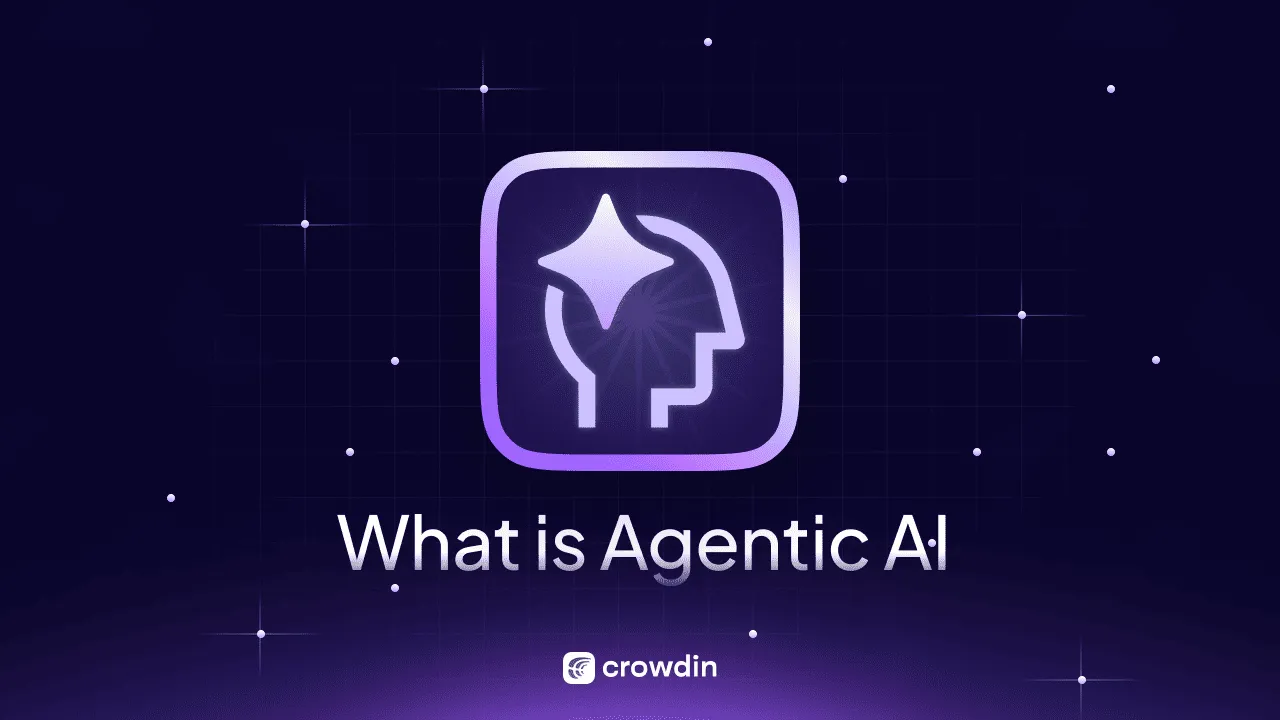What if there was a way to make AI in localization not just faster and more cost-effective, but also smarter? Enter the Agentic AI era, which transforms how we approach translation and localization.
In this article, we’ll explore:
- What Agentic AI is.
- How it differs from earlier AI versions.
- How Agentic AI works.
- Its impact on the localization industry.
- Crowdin’s approach to Agentic AI (features, examples, and how it helps translators).
What is Agentic AI?
Imagine an AI that’s not just another text generator, but a true teammate – one that can understand your goals, plan how to reach them, do tasks, and even learn from its experiences. That’s Agentic AI. It’s an autonomous AI system designed to achieve better results with little human help.
Crowdin Agentic AI can translate a word like “service” correctly by analyzing your app’s code to understand its context. For example, it knows if “service” refers to a pricing plan or to customer assistance. It can choose the correct translation for each case without you having to intervene.
It’s called Agentic because the AI has “agency” – the ability to act independently, reason, and achieve goals with very little human help. Unlike earlier AIs that just react to prompts, an agentic AI can use tools to complete multi-step tasks, operating as a smart agent.
How Agentic AI Differs from Previous Versions
So, how does Agentic AI stand out from earlier AI?
| Feature | Traditional AI (e.g., Rule-based MT) | Generative AI (e.g., LLMs) | Agentic AI (Crowdin’s Approach) |
|---|---|---|---|
| Core Capability | Executes predefined rules | Generates content based on patterns | Achieves goals autonomously |
| Interaction | Rigid, fixed commands | Reactive to prompts | Proactive, goal-driven, conversational |
| Decision Making | None, follows rules | Limited, based on learned data | Independent, adaptive, plans actions |
| Learning | Minimal, manual updates | Continuous, from vast datasets | Continuous, from feedback & environment |
| Context | Very limited | Broad, but often single-turn | Deep, multi-turn, project-specific |
| Tool Use | None | Limited, requires explicit prompting | Extensive, autonomous tool integration |
| Role in Localization | Basic translation, word-for-word | Content generation, preliminary translation | Full workflow orchestration, intelligent assistance |
Traditional AI
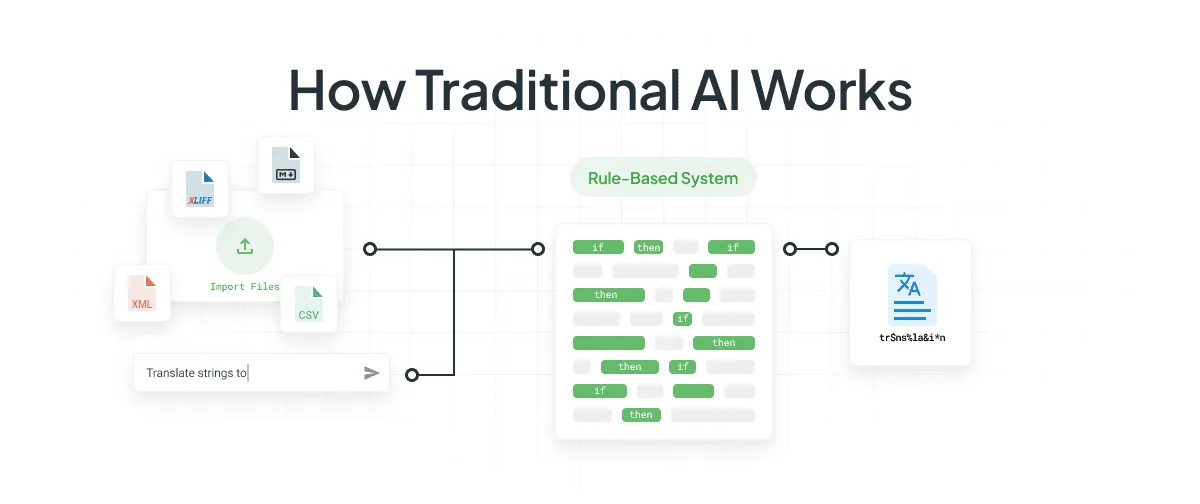
Think of old rule-based systems and early machine translation. Traditional AI follows strict, predefined rules. It does specific tasks but can’t adapt or make independent decisions.
Generative AI

GenAI is great at creating content based on what it’s learned (text, images, code). But it’s still mostly reactive to prompts. They lack long-term memory and are unable to proactively initiate multi-step tasks.
Generative AI translates better when you give it context. For instance, in one experiment, an AI model achieved 49% segments not requiring editing, outperforming a leading MT engine at 29%.
Agentic AI
This is the next step. Agentic AI uses the power of Generative AI but adds autonomy, goal-driven behavior, and adaptability. It can:
- Understand its environment.
- Reason about a task and make a plan.
- Act on its own to follow that plan, often by using other tools.
- Learn and adapt from feedback, getting better over time.
- Remember information and context across many tasks.
See the difference: GenAI can translate a sentence. Agentic AI can localize an entire software application, fix QA issues, and connect with your development tools to get more context.
How Agentic AI Works
Agentic AI works in a way much like how people solve problems. It’s a system where different parts work together:
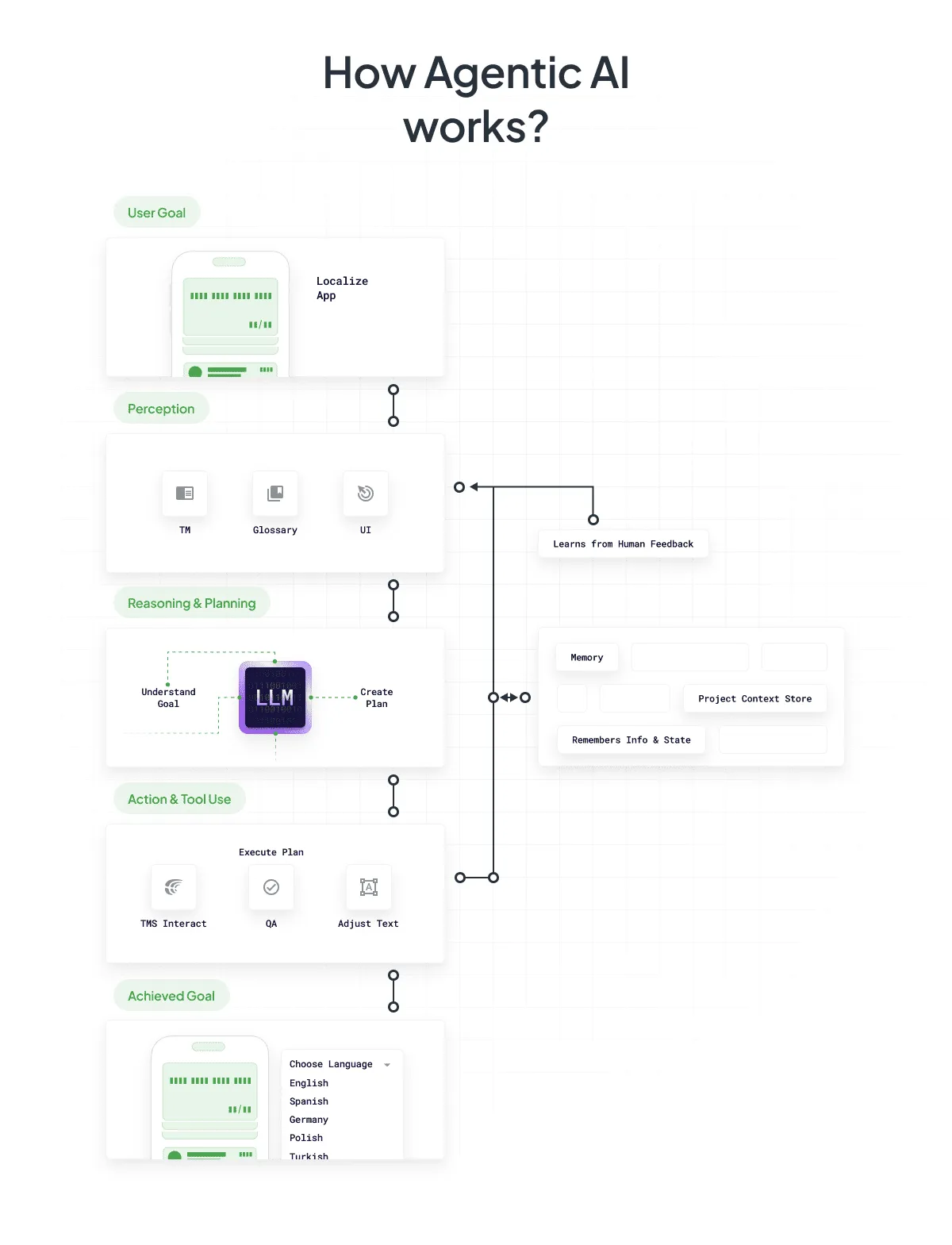
1. Perception
The AI first gathers information. Its most exciting feature is its ability to get context directly from your project’s code repository. It also reads source files, checks translation memories, glossaries, style guides, and screenshots.
How Bounce developed an automation that generates screenshots and uploads them directly to Crowdin
2. Reasoning and Planning
Using an LLM as its “brain”, the AI processes this information. It understands what you want to achieve (e.g., “translate this app formally”, “make sure all marketing is gender-neutral”) and creates a step-by-step plan.
3. Action and Tool Use
It can “take action” by using other tools or software. In localization, this might involve:
- Working with a translation management system like Crowdin.
- Seeking context by analyzing the surrounding source materials.
- Accessing a translation memory or glossary.
- Running/Conducting QA checks based on rules.
- Adjusting text length for user interface limits.
- Rewriting content for specific tones or styles.
4. Learning and Adaptation
After doing a task, the AI checks its results. If a human translator corrects something, the AI learns from it, improving its strategies for future tasks. This continuous learning makes its outputs more accurate over time.
How Agentic AI Affects the Localization Industry
Agentic AI is changing the localization industry in a big way. It’s moving us from manual, reactive processes to automated and very efficient workflows.
Speed and Scalability
Imagine launching new product pages or app updates in multiple languages almost instantly. Agentic AI can handle huge amounts of content, allowing for quick market entry and real-time content updates. Companies using AI-powered tools for content creation have seen time savings of up to 50%, with some social media teams saving as much as 60 h/month.
Better Quality and Consistency
Agentic AI learns from your project’s context and from a linguist’s feedback. This allows it to create translations that are accurate and consistent in tone, style, and cultural relevance. It acts like an “always-on consultant” for your brand rules.
Elevating the Roles of Translators and Localization Managers
The arrival of Agentic AI is changing the nature of translators’ work. They are moving away from translating to proofreading and adjusting AI prompts. The industry is shifting from paying translators per word to paying them hourly, reflecting their changing role. Instead of manual tasks, Agentic AI allows localization managers to focus on adjusting the AI and overseeing the workflow
Content Adaptation
Imagine content being built with localization in mind from the start. Agentic AI helps with “agentic localization”, a process where content is adapted early in the creation process. This approach is key to reducing a product’s time-to-market.
Cost Efficiency
Agentic AI introduces a new expense for companies – a subscription cost for AI tokens. While it’s tempting to think of this as a direct path to cost savings, it’s more accurate to view it as a trade-off.
Cost savings are not always immediate. They may only be realized after a company has invested time in training the AI and finding the right model for their specific needs. The most immediate and certain benefit, however, is a notable increase in translation speed and efficiency.
AI Assistant vs. Agentic AI in Crowdin
These tools look similar, but if you dig deeper, you will see the difference. We created a comparison table, AI Assistant vs. Agentic AI, so you can understand it deeper.
| Feature | AI Assistant | Agentic AI |
|---|---|---|
| Autonomy | Reactive to direct, single-step prompt. | Plans, reasons, and executes multi-step tasks to achieve a goal. |
| Goal Decomposition | Cannot break down complex goals; executes one instruction at a time. | Can decompose a high-level goal into sub-tasks (e.g., Check QA, then change tone). |
| Supports MCP | No | Yes |
| Results | More generic results. | Uses deep project context (MCP, glossaries, TM) and can use Max Mode for increased “thinking” time. |
| Contextual Awareness | Limited to the current string/basic editor context. | Extensive awareness of the entire project, QA settings, user rules, and external files. |
| Speed | Faster | Can be slower due to multi-step planning and tool-calling. |
| Cost | Cheap. Uses fewer tokens per simple request. | Costly. Uses more tokens due to complex reasoning and multiple steps. |
| Requires Prompt | Yes. Requires explicit prompt for every action/request. | No. Can operate with an initial high-level goal, then acts autonomously. |
| Chat-Based Interaction | Yes | Yes |
| Integration with LLMs | Yes | Yes |
To sum up: If you need quick and cheap results, use the AI Assistant. For better-quality translations, try using Agentic AI.
Crowdin’s Agentic AI: Your Smart Localization Partner
Crowdin’s Agentic AI isn’t just another pre-translation tool. It’s a dynamic, context-aware partner that simplifies complex tasks and improves localization quality.
Want to try it?
Here’s how Crowdin’s Agentic AI helps:
1. Deep Project Context
Crowdin’s Agentic AI has access to all your project information. It understands your file setup, uses existing translation memory entries, automatically checks glossaries, considers approval ratings, and even reads code and UI details. This rich context helps the AI make accurate translation suggestions.
2. Conversational Interface
Forget complicated commands. You can talk to Agentic AI in plain language. Need to change the tone of all text from formal to informal? Just ask. Want to ensure gender neutrality in your marketing copy? A simple request does it. It’s like chatting with a smart assistant right in your Сrowdin Editor.

3. Context-Aware Automation & Validation
AI can check translations against your project’s QA rules, making sure they’re correct before delivery. It can also approve translations with one click, saving many hours.
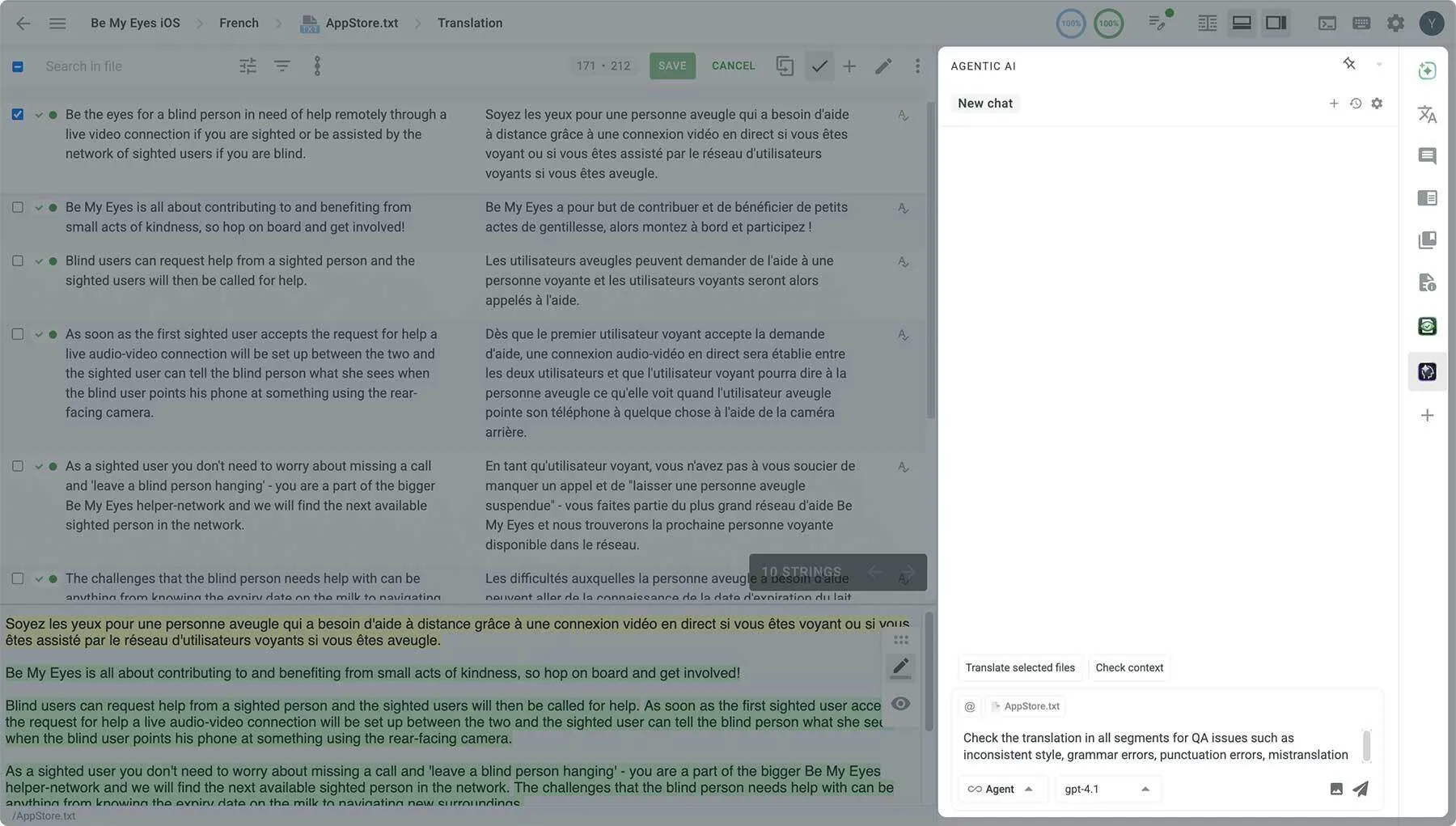
4. Mastering Text Lengths and Style
For UI localization, character limits are often a problem. Agentic AI, guided by your User Rules, makes fitting translated text into strict length limits efficient and accurate. You can also define User Rules to teach the AI your preferred style, ensuring consistent output.
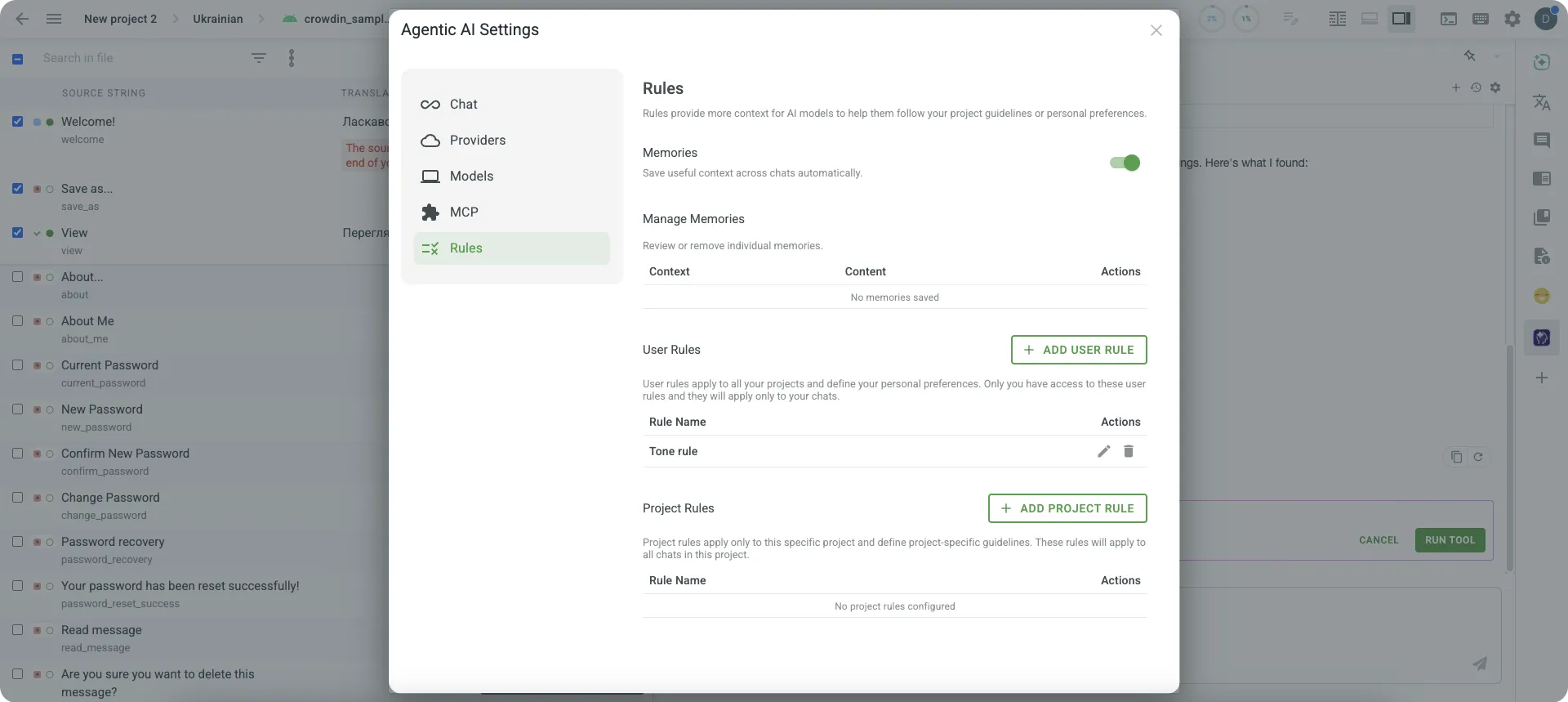
5. Working in Layers
Agentic AI offers a flexible “layered” workflow. You can fine-tune translations step-by-step and add context anytime. Max Mode lets the AI “think through” tool results more deeply, re-check its outputs, and plan next steps, leading to even more accurate results.
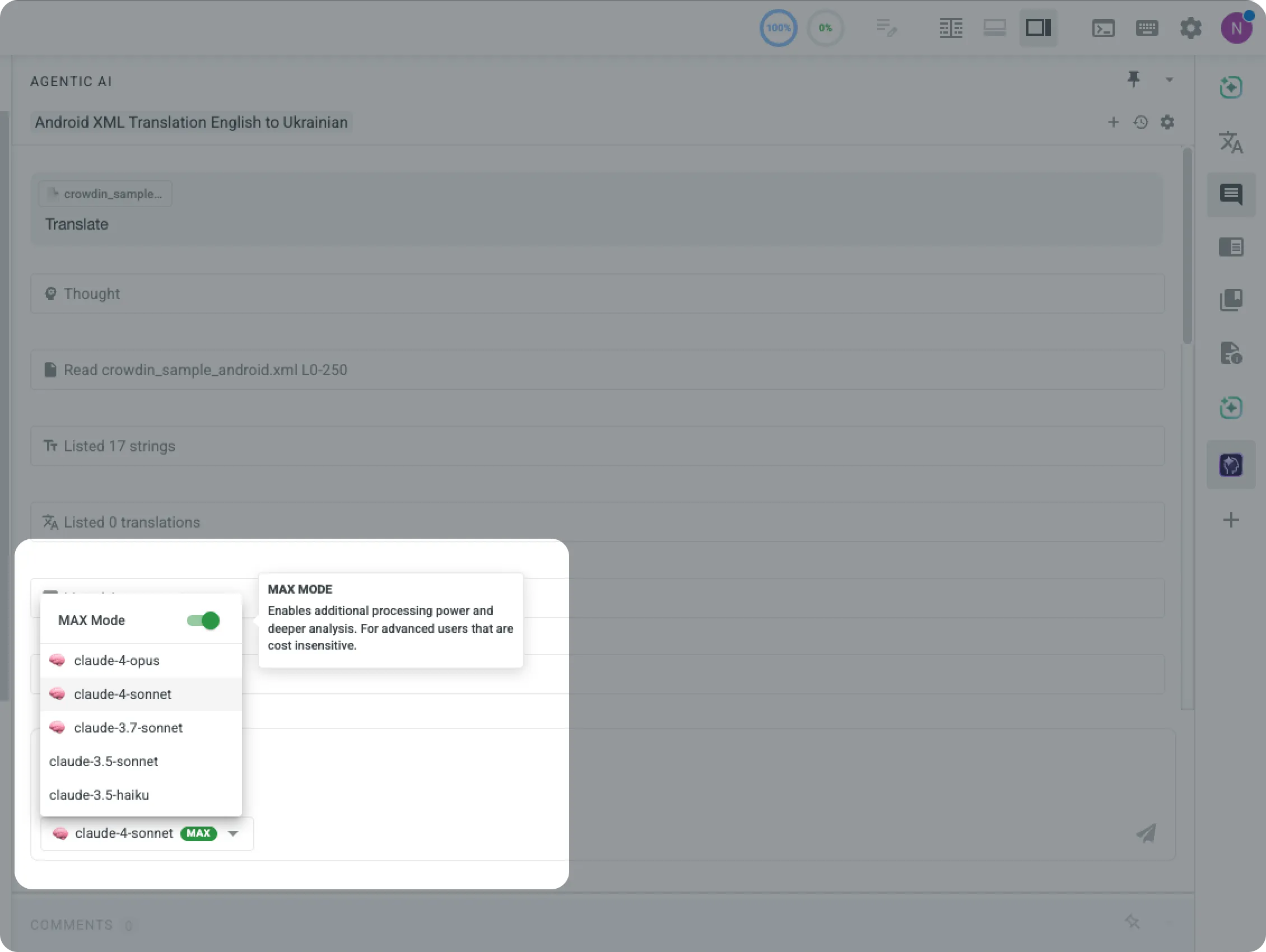
YouTube guide on How to Master Context, Tone, Text Lengths & User Roles with Crowdin's Agentic AI
Flexible AI Providers and Models
At the core of Crowdin’s Agentic AI is a flexible system that lets you integrate with a variety of AI services. You’re not locked into a single provider. Within the Providers section, you can configure access to leading AI companies like OpenAI, Anthropic, and Google Gemini using your own API keys. This is a crucial feature for data privacy and control. It means your data remains yours, and you maintain direct ownership of your usage and costs.
Once you’ve set up your providers, the Models section gives you granular control over which specific AI models you want to use.
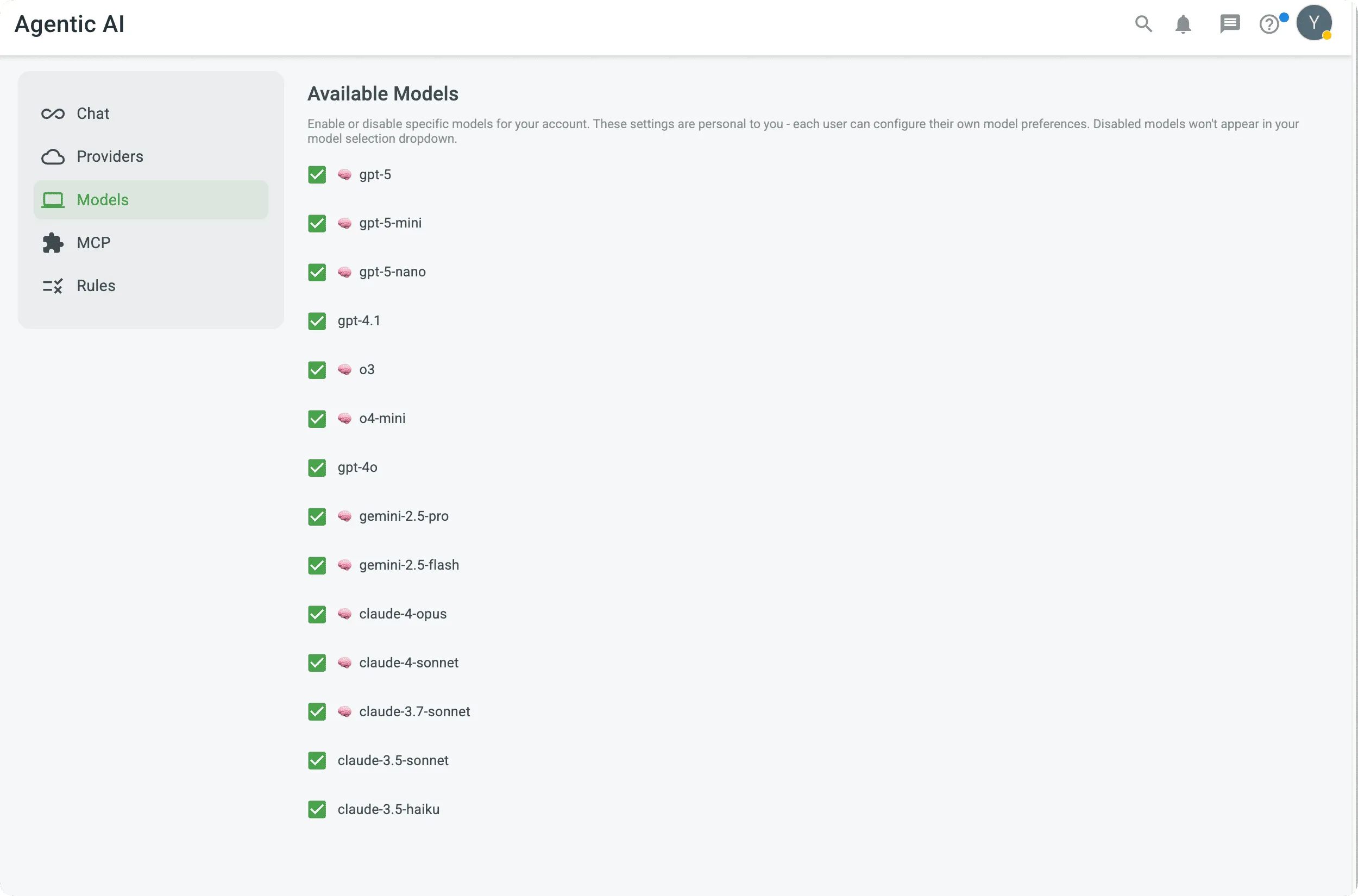
Model Context Protocol (MCP)
Crowdin’s Agentic AI supports with Model Context Protocol. MCP enables direct, structured communication between AI agents and the Crowdin platform.
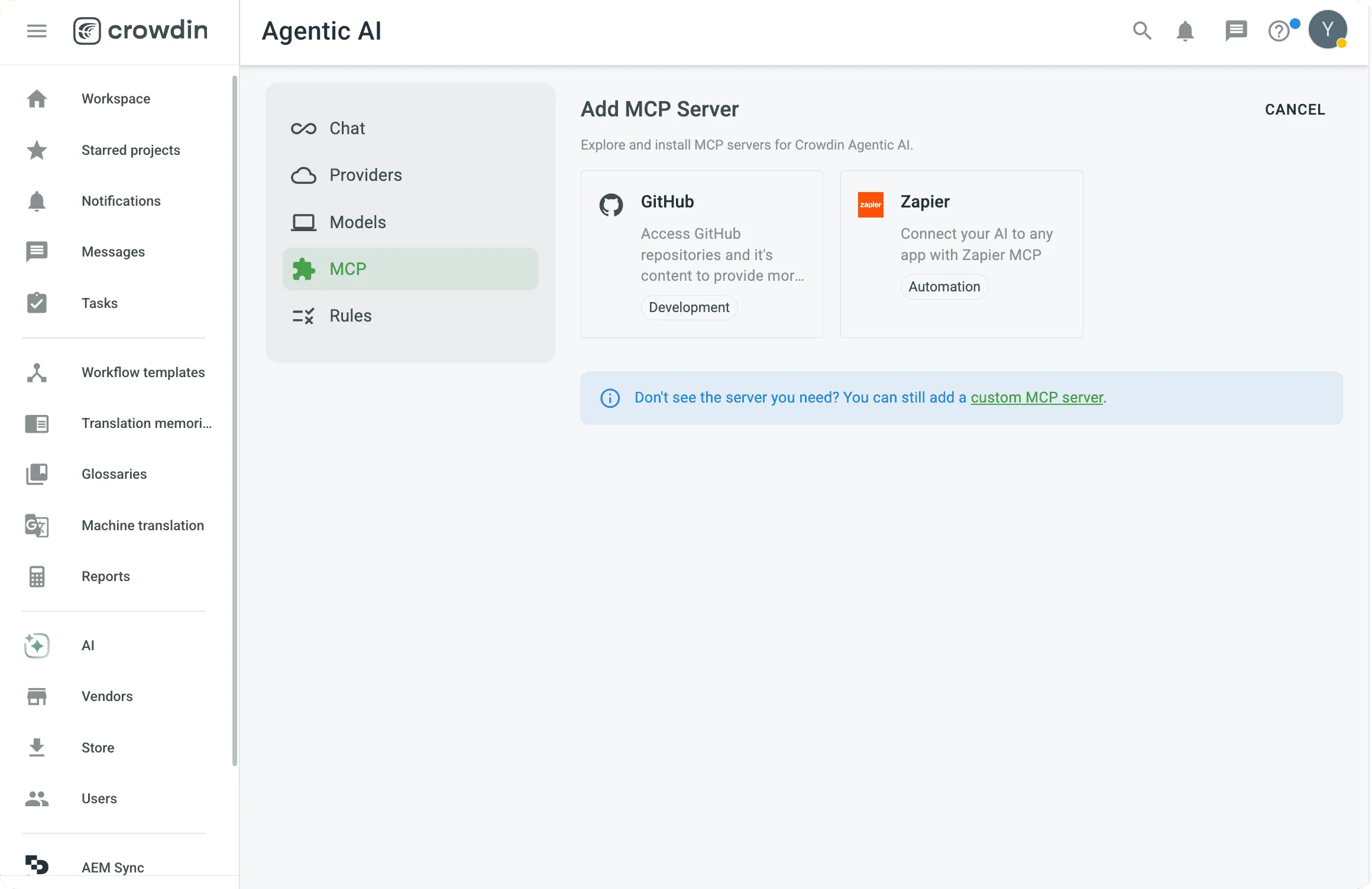
This protocol allows AI to fetch project data, submit translations, perform QA, and gather context in real-time. Crowdin currently offers integrations for GitHub and Zapier, but you can also add your own custom MCP integrations.
Check out our video to see MCP in action.
How Agentic AI in Crowdin Can Help Localization Managers
- Boosted Efficiency. Agentic AI automates repetitive tasks, from initial translation to QA checks.
- Improved Quality. The AI provides context-aware translations by leveraging existing data. This leads to more consistent and accurate content that maintains your brand’s voice.
- Faster Scalability. Managers can expand localization efforts to new languages and high-volume projects without needing a proportional increase in human resources.
- Data-Driven Insights. AI continuously learns from human feedback and market data, helping managers adapt and refine translations to create a stronger local appeal.
- Strategic Focus. AI allows localization managers to shift from task-oriented roles to being strategic leaders who oversee the entire localization workflow.
Conclusion
The age of Agentic AI in localization is here, and it’s transforming the industry.
Crowdin’s Agentic AI is designed to be your smart partner, simplifying complex tasks and freeing you to focus on what truly matters. This is about a new world for localization. AI doesn’t just follow prompts; it understands your goals and actively works to achieve them. The result is a process that’s smarter, faster, and more effective than ever before.
Ready to start your journey into the future of localization?
FAQ
What does “Agentic” mean in the context of AI?
In AI, “agentic” means the system has agency—the ability to act independently. This kind of AI can reason, plan, and take its own initiative to achieve specific goals, all with very little human supervision. Unlike earlier AIs that just react to prompts, an agentic AI can use tools to complete multi-step tasks.
What can Agentic AI in Crowdin do?
- The AI can access your code repository to understand the context of the text it is translating, ensuring more accurate and natural translations.
- It can adjust the length of sentences and refine the tone to be more friendly, less technical, or to match specific brand guidelines.
- Agentic AI can perform various QA checks to ensure translations are consistent, accurate, and free of common errors.
- It can automatically pre-translate content to provide a strong first draft, which significantly speeds up the localization process.
- It maintains Model Context Protocol servers, ensuring that the AI has continuous access to the necessary data to understand and act on the context of the content.
Is Agentic AI secure for sensitive content?
Data security is first. Crowdin prioritizes security by giving you control over your data. You can use your own API keys for leading AI providers, which means you maintain ownership and privacy. Critically, Crowdin has secured contracts with its AI partners to ensure that your data is not used to train or improve their AI models. That guarantees that your information remains confidential.
Yuliia Makarenko
Yuliia Makarenko is a marketing specialist with over a decade of experience, and she’s all about creating content that readers will love. She’s a pro at using her skills in SEO, research, and data analysis to write useful content. When she’s not diving into content creation, you can find her reading a good thriller, practicing some yoga, or simply enjoying playtime with her little one.
